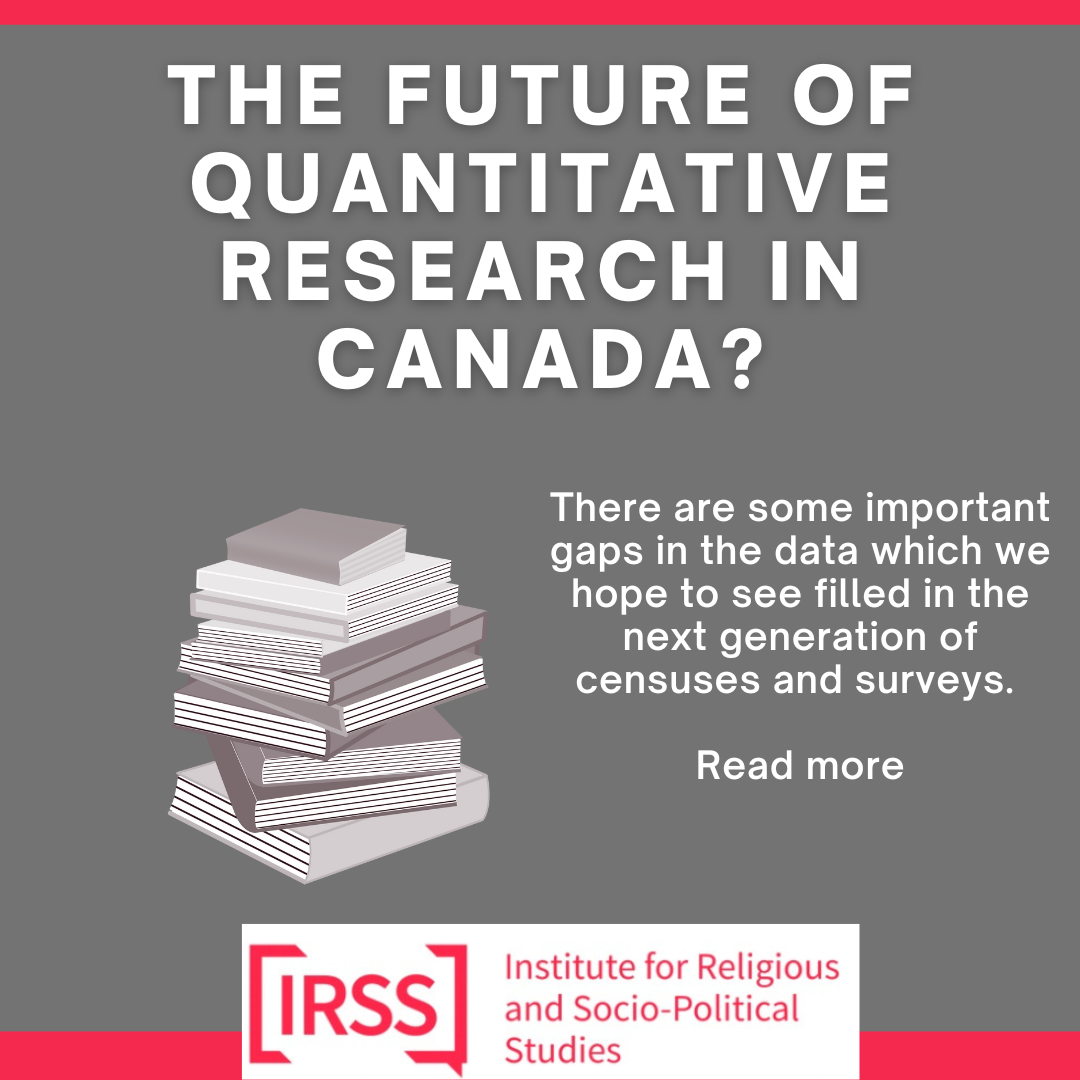
The future of quantitative research on Muslims in Canada?
- Post by: irss
- July 20, 2022
- No Comment
Did you know that much of the statistical data on Muslims in Canada that researchers have to work with comes from just a few main sources? Most of the quantitative data we use comes from Statistics Canada and a few large-scale surveys. Each of these sources has provided the data for many high quality studies, but there are some important gaps in the data which we hope to see filled in the next generation of censuses and surveys.
The Long Form Census
The Canadian census is a rich source of information about numerous aspects of Canadian population and life. For researchers of religious communities, the long form census is most important because it contains questions about religious identity. Census data is very powerful for quantitative studies because it provides a very large sample size, well beyond what any individual researcher or institutional research team could accomplish themselves. The long form census also includes hundreds of questions, providing many data points for analysis.
Unfortunately, questions about religious identity are only included on the long form census, which takes place every 10 years. That means that the currently available census data about Muslims is from 2011. Not only is that quite out of date now, in 2011 the census was optional thanks to changes made by the Harper government. That means that 2011’s data is likely to be skewed, and is thought to be particularly inaccurate about more marginalized populations. Fortunately, the census was made mandatory again in 2015.
The next long form census took place in 2021, and the raw data will continue to be released throughout this year. Soon, researchers will have a new batch of data to work with. One challenge that remains, however, is that even the long form census does not ask more detailed questions about religious identity such as specifying denomination or sect.
Longitudinal Immigration Database
Another important source from Statistics Canada is the longitudinal immigration database, which provides immigration and taxation files from 1980-2017 and a longitudinal survey of immigrants to Canada which follows statistical changes in immigrant groupings for five years following their arrivals in 2000-2001. The 1980-2017 immigration and taxation data doesn’t include religious identity, but both datasets have the benefit of providing longitudinal information (the data shows trends over time, rather than at a single moment). Researchers have also combined the data to create more complex datasets.
Aside from being increasingly out of date, the major issue with this data is that it focuses on immigrant populations. Second generations and onward are excluded from studies using this data and findings on things like economic integration over time can only be generalized to Muslim immigrants, not the Muslim population at large.
Large-scale Surveys of Muslims in Canada
The Statistics Canada General Social Surveys and the Environics Institute surveys are the two major large-scale surveys providing data on Muslims in Canada. Both offer more recent data than the federal census but have still become dated, with the last General Social Survey being done in 2013 and the Environics surveys of Muslims having been done in 2006 and 2016. Although the Environics survey has a smaller sample size, it was developed in collaboration with scholars, community leaders and Islamic organisations, so it contains data on a variety of relevant themes.
A new General Social Survey is currently underway and it will include a larger Muslim sample than previously. A future Environics survey is also slated for the near future. Both surveys will provide interesting, fresh information for researchers, among other ventures.
The Future of Quantitative Research on Muslims in Canada
With new census data being released and new large-scale surveys in the works, researchers will be able to capture a more current picture of the condition and state of Muslims in Canada, which will allow governments and organizations to make more relevant and informed policy decisions. However, gaps remain, such as the lack of longitudinal data on generations of Muslims born in Canada, and more detailed identity variables.
Quantitative data can be extremely powerful. It is an effective way to paint a picture of “on the ground” reality; debunking assumptions, revealing unexpected trends, identifying gaps in our knowledge, and very often confirming observed trends and issues reported by the community. Having robust, current, high quality data is therefore very important for policy makers, community leaders and organizers.
One institution working to address gaps in statistical data is the Islamic Studies Institute at the University of Toronto. In 2021, they launched the Muslims in Canada Data Initiative (MiCDI) to build on the 2021 census data and support a future Environics survey in the near future.
Another way to strengthen and fill the gaps in the available quantitative data is with qualitative and mixed-method studies. While quantitative data is indisputably important, qualitative data is also very powerful and is more readily available. Qualitative studies are typically smaller scale than quantitative, but they can provide a nuance and depth of insight that can get lost in numbers. Qualitative and quantitative studies often confirm and reinforce each others’ findings; and the two types of data can often be best used together. As Muslim populations in Canada continue to grow, paying attention to our data is ever crucial going forward.
